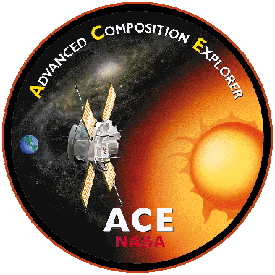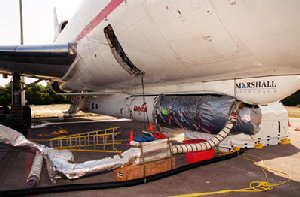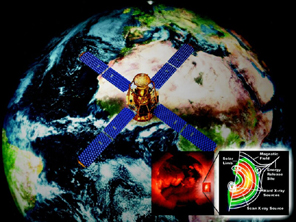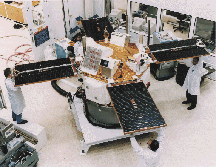Click on image for full size
Image courtesy of NASA
ACE Mission Page
The ACE (Advanced Compostion Explorer) was launched aboard a Delta II rocket in August 1997. This unique NASA mission will run a minimum of 2 years (with an expected lifetime of over 5 years). This mission has some lofty, but exciting goals!Have you ever wondered what you are made of? Where did the elements come from that make up your body? The elements that make up your body are the same elements found on the Earth we live on. Where did those earthen elements come from? Most would say that the building blocks of the Earth (and the other planets) came from the Sun...and that solar material came from the galaxy, and the galactic material came from the universe...
So you see, if we can better understand the composition of the universe, the Milky Way galaxy, and our Sun, we can better understand how the solar system formed, the elemental composition of the Earth, and perhaps, even our own bodies! This is exactly what the ACE spacecraft is designed to do! The primary mission of the ACE spacecraft is to study the energetic particles that come near the Earth from the Sun, from the space between the planets, and from the Milky Way galaxy beyond the solar system.
ACE's nine instruments help provide comprehensive analysis of particles arriving at the spacecraft. The instruments on ACE are 10 to 1000 times more powerful than previous instruments that have been flown in space.
The ACE spacecraft will track the solar wind coming from the Sun with special interest lying in times of increased solar activity. The mission also traces galactic cosmic rays which come from interstellar space located beyond the heliosphere (that which is beyond the influence of the IMF), but generally from within our galaxy. The ACE satellite also serves as a spaceweather station while in orbit. The location of ACE enables it to provide about one-hour advance warning of any major geomagnetic activity (caused by coronal mass ejections)that can cause electrical surges or radio, t.v., and telephone communication loss here on Earth.
The ACE mission is an important addition to past and current studies including Ulysses, SOHO and WIND.
The ACE mission has had an extremely successful mission so far. It recently (June 1998) made some exciting discoveries about coronal mass ejections. Here's an animation which describes more...













